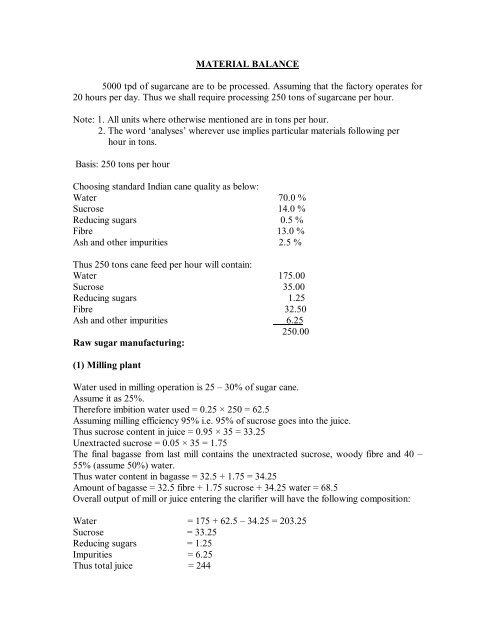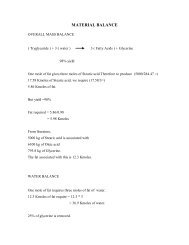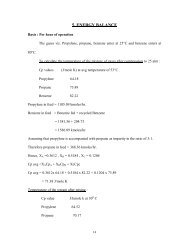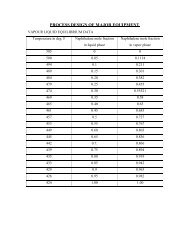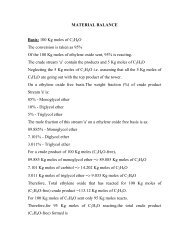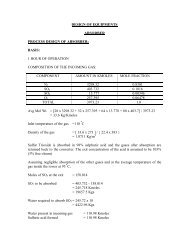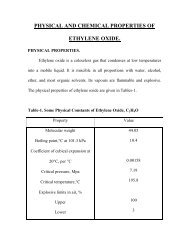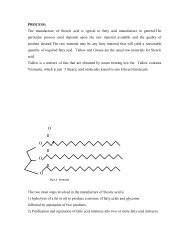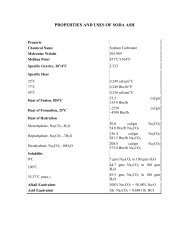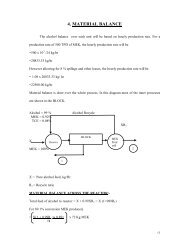MATERIAL BALANCE 5000 tpd of sugarcane are to be processed ...
MATERIAL BALANCE 5000 tpd of sugarcane are to be processed ...
MATERIAL BALANCE 5000 tpd of sugarcane are to be processed ...
You also want an ePaper? Increase the reach of your titles
YUMPU automatically turns print PDFs into web optimized ePapers that Google loves.
<strong>MATERIAL</strong> <strong>BALANCE</strong><br />
<strong>5000</strong> <strong>tpd</strong> <strong>of</strong> <strong>sugarcane</strong> <strong>are</strong> <strong>to</strong> <strong>be</strong> <strong>processed</strong>. Assuming that the fac<strong>to</strong>ry operates for<br />
20 hours per day. Thus we shall require processing 250 <strong>to</strong>ns <strong>of</strong> <strong>sugarcane</strong> per hour.<br />
Note: 1. All units where otherwise mentioned <strong>are</strong> in <strong>to</strong>ns per hour.<br />
2. The word ‘analyses’ wherever use implies particular materials following per<br />
hour in <strong>to</strong>ns.<br />
Basis: 250 <strong>to</strong>ns per hour<br />
Choosing standard Indian cane quality as <strong>be</strong>low:<br />
Water 70.0 %<br />
Sucrose 14.0 %<br />
Reducing sugars 0.5 %<br />
Fibre 13.0 %<br />
Ash and other impurities 2.5 %<br />
Thus 250 <strong>to</strong>ns cane feed per hour will contain:<br />
Water 175.00<br />
Sucrose 35.00<br />
Reducing sugars 1.25<br />
Fibre 32.50<br />
Ash and other impurities 6.25<br />
250.00<br />
Raw sugar manufacturing:<br />
(1) Milling plant<br />
Water used in milling operation is 25 – 30% <strong>of</strong> sugar cane.<br />
Assume it as 25%.<br />
Therefore imbition water used = 0.25 × 250 = 62.5<br />
Assuming milling efficiency 95% i.e. 95% <strong>of</strong> sucrose goes in<strong>to</strong> the juice.<br />
Thus sucrose content in juice = 0.95 × 35 = 33.25<br />
Unextracted sucrose = 0.05 × 35 = 1.75<br />
The final bagasse from last mill contains the unextracted sucrose, woody fibre and 40 –<br />
55% (assume 50%) water.<br />
Thus water content in bagasse = 32.5 + 1.75 = 34.25<br />
Amount <strong>of</strong> bagasse = 32.5 fibre + 1.75 sucrose + 34.25 water = 68.5<br />
Overall output <strong>of</strong> mill or juice entering the clarifier will have the following composition:<br />
Water = 175 + 62.5 – 34.25 = 203.25<br />
Sucrose = 33.25<br />
Reducing sugars = 1.25<br />
Impurities = 6.25<br />
Thus <strong>to</strong>tal juice = 244
(2) Clarifier<br />
Reagent used: lime (0.5 kg lime/<strong>to</strong>n <strong>of</strong> sugar cane)<br />
Thus lime <strong>to</strong> <strong>be</strong> added = 0.5 × 250 = 125 kg = 0.125 <strong>to</strong>n<br />
Assume 96% efficiency <strong>of</strong> clarifier <strong>to</strong> remove impurities.<br />
Therefore impurities <strong>to</strong> <strong>be</strong> removed = 0.96 × 6.25 = 6.00<br />
Total sludge from clarifier = 0.125 + 6.0 = 6.125<br />
Amount <strong>of</strong> clarified juice entering in the evapora<strong>to</strong>r = 244 – 6.0 = 238<br />
This clarified juice is fed <strong>to</strong> the first effect <strong>of</strong> the quadruple effect evapora<strong>to</strong>r and<br />
analyses as follows:<br />
Water 203.25<br />
Sucrose 33.25<br />
Impurities 0.25<br />
Reducing sugars 1.25<br />
Thus <strong>to</strong>tal juice 238.00<br />
% <strong>of</strong> solids in this juice = {(33.25 + 0.25 + 1.25) × 100}/238 = 14.60<br />
(3) Evapora<strong>to</strong>r<br />
Typical evapora<strong>to</strong>r load = 75 – 80% <strong>of</strong> clarified juice<br />
Assume 76% <strong>of</strong> clarified juice as evapora<strong>to</strong>r load.<br />
Thus evapora<strong>to</strong>r load = 0.76 × 238 = 180.88<br />
Input <strong>to</strong> the evapora<strong>to</strong>r = (203.25 water + 33.25 sucrose + 0.25 impurities + 1.25 reducing<br />
Sugars)<br />
= 238<br />
Water removed in the evapora<strong>to</strong>r = 180.88<br />
Water remaining in the juice = 203.35 – 180.88 = 22.37<br />
Hence output <strong>of</strong> evapora<strong>to</strong>r analyses as follows:<br />
Water 22.37<br />
Sucrose 33.25<br />
Impurities 0.25<br />
Reducing sugars 1.25<br />
Thus <strong>to</strong>tal solution 57.12<br />
% <strong>of</strong> solids in this concentrated solution = {(33.25 + 0.25 + 1.25) × 100}/57.12 = 60.84<br />
(4) Crystallizer 1<br />
Crystallization <strong>of</strong> concentrated juice is done in a vacuum pan crystallizer. Crystallization<br />
is done at vacuum not exceeding 25 in (635mm).<br />
Hence assume 580 mm Hg vacuum in crystallizer.<br />
Therefore absolute pressure = 760 - 560<br />
= 280 mmHg<br />
= (280 × 1.013)/760 bar
= 0.2666 bar<br />
Thus boiling point (from steam table) at this pressure = 61.42 0 C<br />
Boiling point rise = 4 0 C<br />
Solubility <strong>of</strong> sucrose in water is given by<br />
Y = 68.18 + 0.1348 × t + 0.000531 × t<br />
Where Y is % sucrose at saturation<br />
t is temperature in 0 C<br />
At 65.42 o C, Y <strong>be</strong>comes = 73.03%<br />
Therefore sucrose per kg <strong>of</strong> water = Y/(100 – Y) = 73.03/(100 - 73.03)<br />
= 2.71 kg Sucrose/ kg <strong>of</strong> water<br />
But since impurities <strong>are</strong> present. Therefore purity can <strong>be</strong> calculated as<br />
Purity = wt. <strong>of</strong> sucrose/ <strong>to</strong>tal wt. <strong>of</strong> solids<br />
= 3.25/(33.25 + 0.25 + 1.25)<br />
= 0.957 i.e. 95.7%<br />
Hence the solubility is reduced by fac<strong>to</strong>r called solubility coefficient.<br />
For purity <strong>of</strong> 95.7%, Solubility coefficient = 0.97<br />
Thus effective solubility = 2.71 × 0.97<br />
= 2.6287 kg <strong>of</strong> sucrose/kg <strong>of</strong> water<br />
Input <strong>to</strong> crystallizer = (22.37 water + 33.25 sucrose + 1.25 reducing sugars + 0.25<br />
impurities)<br />
Assume 92% <strong>of</strong> sucrose recovery as crystal with respect <strong>to</strong> initial sucrose content in feed.<br />
Weight <strong>of</strong> sucrose crystal formed = 0.92 × 33.25<br />
= 30.59<br />
Weight <strong>of</strong> reducing sugar crystals = 0.33 × 1.25<br />
= 0.4125<br />
Moisture associated with crystals = 1% <strong>of</strong> crystal weight<br />
= 0.01 × 30.59 + 0.01 × 0.4125<br />
= 0.3059 + 0.004125<br />
= 0.3100<br />
Sucrose in molasses = 33.25 - 30.59<br />
= 2.66<br />
Reducing sugar left in molasses = 1.25 – 0.4125 = 0.8375<br />
Total sugar in molasses = 2.66 + 0.8375 = 3.4975<br />
Water required <strong>to</strong> dissolve this = 3.4975/2.6287 = 1.331<br />
Hence water <strong>to</strong> <strong>be</strong> evaporated = initial water – associated water – water in molasses<br />
= 22.37 – 0.31 – 1.331<br />
= 20.729<br />
Out put <strong>of</strong> crystallizer:<br />
(a) Solids: 31.4375<br />
(30.59 sucrose + 0.3059 water) crystals +<br />
(0.4125 reducing sugars + 0.004125 water) crystals +<br />
0.125 impurities<br />
(b) Molasses: 4.9535
(1.331 water + 2.66 sucrose + 0.8375 reducing sugar + 0.125<br />
impurities)<br />
(a) + (b) = Input <strong>to</strong> centrifuge = 31.4375 + 4.9535 = 36.3910<br />
(5) Centrifuge<br />
Assume 10% molasses adheres <strong>to</strong> the crystal.<br />
Output <strong>of</strong> centrifuge<br />
= (30.59 sucrose + 0.3059 H 2 O) + (0.4125 reducing sugars + 0.004125 H 2 O)<br />
+ 0.125 impurities + 0.4954 molasses<br />
= 31.9329<br />
= input <strong>to</strong> affination step<br />
CANE SUGAR REFINING:<br />
(6) Affination<br />
The first step in refining process is called affination or washing and consists <strong>of</strong> removing<br />
the adhering film molasses from the surface at the raw sugar crystal.<br />
The separation process involves mingling the raw with a heavy syrup (about 75% solids)<br />
then purging the mixture in centrifugals and washing with hot water after the syrup has<br />
<strong>be</strong>en spun <strong>of</strong>f.<br />
Best magma temperature is 43 0 C.<br />
Lyle warned “sugar loss in affination may <strong>be</strong> very large especially if the syrup is s<strong>to</strong>red in<br />
tanks where it is heated”.<br />
Assuming 5% <strong>of</strong> sucrose is lost in affination along with molasses.<br />
Output <strong>of</strong> affination step (i.e. washed sugar) analyses as follows:<br />
Sucrose = 30.59 – 0.05 × 30.59<br />
= 29.0605<br />
Water = 0.31<br />
Reducing sugars = 0.4135<br />
Impurities = 0.125<br />
Total = 29.909<br />
(7) Melting or dissolving the washed sugar<br />
The washed sugar is dissolved in about one-half its weight <strong>of</strong> water in a tank provided<br />
with mixing arms and called a melter, exhaust steam <strong>be</strong>ing applied from a perforated coil<br />
<strong>to</strong> aid solution.<br />
Therefore water added for melting = 29.0605/2<br />
= 14.5302<br />
Therefore melt sugar analyses as follows:<br />
Sucrose = 29.0605<br />
Water = 0.31 + 14.5303
= 14.8403<br />
Reducing sugars = 0.4135<br />
Impurities = 0.125<br />
Total = 44.4393<br />
(8) Defecation or clarification<br />
(a) Prescreening <strong>of</strong> liquors - screening <strong>of</strong> melt liquors <strong>to</strong> remove strings, jute, twine and<br />
other coarse material has always <strong>be</strong>en cus<strong>to</strong>marily but only during the past two decades<br />
has it <strong>be</strong>come standard practice <strong>to</strong> subject liquors <strong>to</strong> fine screening.<br />
But here assume that there is no such types <strong>of</strong> material in melt liquor.<br />
(b) Lime – in the batch system, first a part <strong>of</strong> the lime was added, neat the required P 2 O 5<br />
then the remainder <strong>of</strong> the lime, <strong>to</strong> give a pH <strong>of</strong> 7.0 <strong>to</strong> 7.3 on the clarified liquor.<br />
The amount <strong>of</strong> lime used ranges from 400 <strong>to</strong> 500 lb CaO per 10 6 lb melt, the average<br />
yearly figure for one refinery using Williamson clarification <strong>be</strong>ing 460 lb <strong>of</strong> CaO with<br />
175 lb <strong>of</strong> P 2 O 5 i.e. 635 <strong>to</strong>n per 10 6 <strong>to</strong>n melt.<br />
Therefore lime <strong>to</strong> <strong>be</strong> added = (44.4393 × 635)/10 6<br />
= 0.0282 <strong>to</strong>ns/hr<br />
The reducing sugar does not dissolve in water and it goes along with sludge.<br />
Assuming all impurities <strong>are</strong> removed and efficiency <strong>of</strong> the clarifier as 100%.<br />
Thus the solution from clarifier contains sucrose and water & the sludge contains<br />
phosphate precipitate and reducing sugars.<br />
The solution from this clarifier analyses as follows:<br />
Water 14.8403<br />
Sucrose 29.0605<br />
Total 43.9008<br />
(9) Decolourization<br />
Assuming the colouring matter content in the solution from clarification as 2% <strong>of</strong><br />
sucrose.<br />
Therefore colouring matter = 0.02 × 29.0605<br />
= 0.5812<br />
Assume all colour is removed in the bone char <strong>be</strong>d decolourizer.<br />
Thus colour removed = 0.5812<br />
Solution from decolourizer analyses as follows:<br />
Sucrose = 29.0605 – 0.5812<br />
= 28.4793<br />
Water = 14.8403<br />
Total = 43.3196<br />
(10) Crystallizer 2<br />
Assuming same pressure as that <strong>of</strong> crystallizer 1.<br />
Therefore solubility <strong>of</strong> sucrose in water as calculated <strong>be</strong>fore = 2.71 kg sucrose/kg water
Here no impurities <strong>are</strong> present, hence there is no need <strong>to</strong> consider solubility coefficient.<br />
Assume 92% sucrose recovery as crystals with respect <strong>to</strong> initial sucrose content in feed.<br />
Therefore weight <strong>of</strong> crystals formed = 0.92 × 28.4793 = 26.2010<br />
Moisture associated = 0.01 × 26.2010 = 0.26201<br />
Sucrose in molasses = 28.4793 – 26.2010<br />
= 2.2783<br />
Therefore water in molasses = 2.2783 ÷ 2.71 = 0.8407<br />
Hence water <strong>to</strong> <strong>be</strong> evaporated = initial water – associated water – water in molasses<br />
= 14.8403 – 0.26201 – 0.8407<br />
= 13.7376<br />
Assume 10% <strong>of</strong> molasses adheres <strong>to</strong> crystal in centrifuge.<br />
Therefore molasses adhered = 0.10 × (2.2783 + 0.8407)<br />
= 0.10 × 3.1190<br />
= 0.3119<br />
Wet crystals from centrifuge analyses as follows:<br />
Sucrose = 26.2010 + {(0.3119 × 2.2783)/3.119}<br />
= 26.4288<br />
Water = 0.26201 + {(0.3119 × 0.8407)/3.119}<br />
= 0.3461<br />
Total = 26.7749<br />
(11) Drying<br />
The deterioration <strong>of</strong> sugar is retarded and the loss in test is reduced if the moisture<br />
content <strong>of</strong> the sugar is reduced. With a dryer, the moisture content may <strong>be</strong> reduced <strong>to</strong><br />
<strong>be</strong>tween 0.2 and 0.5%.<br />
Drying by contact with hot air involves heating the air, <strong>to</strong> increase the capacity for<br />
absorbing water and bringing it in<strong>to</strong> intimate contact with the sugar from which it<br />
evaporates the moisture.<br />
Assume that the final moisture content is 0.2%.<br />
Weight <strong>of</strong> dry crystal is 26.4288 as calculated <strong>be</strong>fore.<br />
Therefore final sugar produced = 26.4288 ÷ (1 – 0.002) = 26.4818<br />
Thus overall yield <strong>of</strong> refined sugar based on cane crushed = (26.4818 ÷ 250) × 100<br />
= 10.59%<br />
Thus moisture <strong>to</strong> <strong>be</strong> removed = m = 26.7749 – 26.4818<br />
= 0.2931 <strong>to</strong>ns/hr<br />
= 293.1 kg/hr<br />
There <strong>are</strong> two possible methods <strong>of</strong> circulation <strong>of</strong> air and sugar.<br />
i.e. parallel flow and countercurrent flow.<br />
For safety, the calculation is based on most unfavourable condition, i.e. it is assumed that<br />
the ambient air is saturated. On the other hand, the air leaving a dryer is generally not<br />
saturated; it is assumed that in case <strong>of</strong> countercurrent flow, it has absor<strong>be</strong>d only two-
thirds <strong>of</strong> the quantity <strong>of</strong> water that it could have absor<strong>be</strong>d if it had left in a saturated<br />
condition.<br />
We have then, in the case <strong>of</strong> countercurrent condition,<br />
A = (100 × m) ÷ {(2 ÷ 3) × (H 1 – H 0 )} = (1500 × m) ÷ (H 1 – H 0 )<br />
Where A – weight <strong>of</strong> air <strong>to</strong> <strong>be</strong> passed through dryer (kg/hr)<br />
m – moisture <strong>to</strong> <strong>be</strong> removed (kg/hr)<br />
H 0 – weight <strong>of</strong> water vapour contained in saturated air at a temperature t 0 <strong>of</strong> entry<br />
air <strong>to</strong> the heater (ambient temperature) in kg/1000 kg<br />
Taking ambient temperature as 30 o C.<br />
From fig. 36.3 (Hugot)<br />
H 0 = 26 kg water/1000 kg saturated air<br />
H 1 – weight <strong>of</strong> water vapour contained in saturated air at the temperature t 1 <strong>of</strong> exit<br />
From the dryer in kg/1000 kg<br />
The temperature <strong>of</strong> air leaving the dryer is in <strong>be</strong>tween the 45 – 52 o C.<br />
Assuming it as 50 o C.<br />
From fig. 36.3 (Hugot)<br />
H 1 = 85 kg water/1000 kg saturated air<br />
Therefore A = (1500 × 293.1) ÷ (85 – 26) = 7451.69 kg/hr<br />
Thus weight <strong>of</strong> air <strong>to</strong> <strong>be</strong> passed through the dryer = A = 7451.69 kg/hr<br />
Hence volume <strong>of</strong> air required = V = A ÷ (a 0 + e 0 )<br />
From fig. 36.3 and 36.4 (Hugot)<br />
a 0 = density <strong>of</strong> air at t 0 = 1.12 kg/m 3<br />
e 0 = weight <strong>of</strong> vapour contained in saturated air at t 0 = 0.03 kg/m 3<br />
Therefore V = 7451.69 ÷ (1.12 + 0.03) = 6479.73 m 3 /hr


